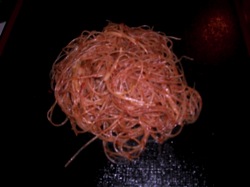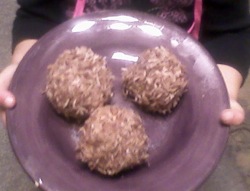There’s a whole lot of Trek going on at tor.com these days, what with the reviewing of the original series here and the movie premiering this weekend. Here’s my contribution.
I enjoy the Star Trek universe in general, but my favorite incarnation has always been The Next Generation. I’m especially fond of Worf. How can you not dig a guy who thinks prune juice is for warriors and understands the role of poetry and dodging thrown objects during courtship? Klingon love is like full-contact Neruda.
I’ve always considered myself something of an honorary Klingon, less for the poetic danger-sex than for my genetic predisposition to look Klingonesque. Though I’ve never heard it stated outright, I’ve always presumed that Klingons were based, in part, on Mongols and Arabs. That would explain why all I have to do is furrow my brow and, voila, instant son of Kahless.
There are tons of food references on the various Trek shows. I could go on for a year making nothing but Star Trek recipe posts. But for this entry I’ve chosen two items in particular. One is probably the most famous alien food on the show; the other is something not intended for food at all, but I couldn’t resist. So, first up: qagh.
Initial thoughts: I hesitated to recreate this at first, because there are plenty of recipes out there, and the concept from the show isn’t really complicated. It’s got two ingredients: dying worms and poison. Yum. I decided to take it on for a few reasons. A) I could hardly get away with a series on scifi food without covering it and B) none of the recipes I had seen appealed to me.
Since, as I mentioned earlier, I think of Klingons as Arab-Mongols, my concept for qagh draws from both Middle and Far East. For the worms themselves, I decided on bean threads, AKA cellophane noodles. They’re peculiar looking. They’re not hard to find. They’re inexpensive and easily prepared. I added bean sprouts for texture. The flavor is neutral which allows me to focus on the sauce.
The sauce is inspired by muhammara, a Syrian red pepper dip. Muhammara calls for Pomegranate Molasses which is not so easy to find outside of Arabic markets (though it’s great stuff!) so I’m opting for partly reduced pomegranate juice, which is not hard to find and available year-round in many stores.
 qagh:
qagh:
1 8oz package of Cellophane noodles (rice vermicelli also works)
1 lb bean sprouts
1 red bell peppers
1 cloves of garlic
1 teaspoon salt
2 cups pomegranate juice
1/2 cup walnuts or pecans
Pepper sauce, such as Tabasco (optional)
Boil enough water to cover the noodles. Don’t actually cook them, just cover them with hot water so that they’ll soften. Let them sit in the water about 15 minutes, then drain.
While the noodles are reconstituting, roast the bell pepper over a flame or in a broiler until soft. While it cools, toast the nuts in a dry pan until they begin to darken. Simmer the pomegranate juice until reduced by half.
After the bell pepper cools, cut out the stem, seeds and pith. Put the bell pepper, garlic, nuts, salt and reduced juice in a blender or food processor until pureed. Add this mixture to the drained noodles and mix it all together.
Bring about six cups of water to a boil and cook the bean sprouts for about 45 seconds. Drain and add to the noodles and sauce. Serve cold or warm. If you want it to have a little heat, add pepper sauce to taste.
For Dessert: Tribbles!
I think the inspiration for this dessert came from the phonic similarity between tribble and trifle. This is a very kid-friendly recipe, so if you have a budding chef at home, enlist his or her help.
OK, I know tribbles were never meant to be eaten. I couldn’t resist, though. I mean, think of what a plentiful food supply they’d be!
 You will need:
You will need:
1 box of regular old yellow cake mix
eggs and/or oil as required by the cake mix package directions
1 box of instant vanilla pudding mix
3 cups milk
2 cups shredded sweetened coconut (possibly more)
a tablespoon or so chocolate syrup
Bake the cake as directed on the box. Allow it to cool completely and then break it up into roughly hazelnut-sized bits in a large bowl. Add the milk to the instant pudding in a separate bowl. In yet another bowl, mix the chocolate syrup and coconut. Be sparing with the chocolate; it’s mainly to give the coconut a little color. Too much will make it too clumpy to use.
Mix one cup of pudding with the cake bits. Add more gradually, until it forms a mixture just wet enough to hold shape. Reserve at least one cup of pudding.
Form the cake/pudding mix into balls around 3 inches. On a baking sheet, spread the coconut mixture. Using the reserved pudding, lightly coat each ball with pudding and roll in the coconut. Repeat until they’re all done.
Live long and prosper, my friends. See you next week, when I tackle the other famous scifi source with “Star” in the title.









